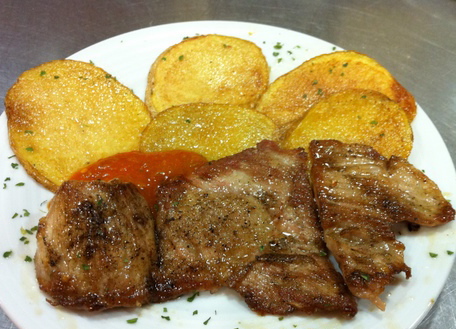Jam session
We're jammin' -
To think that jammin' was a thing of the past;
We're jammin',
And I hope this jam is gonna last
I'm not a savvy preserver or a sugar plum fairy by any means, I'm more of a quick-pickle guy. Well preserved I are and all plummed up but in no way a jammy queen, and when it comes to jam making I´m more a jammy dodger, one who likes to get it done, bottled with minimum effort and onto that larder shelf as quickly as possible.However preserving is now very much back in fashion and, though thought to be caused by the recession and the need to cut back, the myth that making jams and preserves is cheaper than shop bought, is not always true.
My need to preserve is not about being thrifty and usually starts about now, as the last of the soft fruits hit the market and the first hint of autumn wafts in, and then returns again in February when our orange tree bears the bitter fruits of the Seville Orange.
Why I need to fill the CasaRosada store cupboard needs no justification.There are year round guests to be fed and breakfast jam pots to be replenished on a daily basis.
An afternoon jam session of choppin´, stirrin´, bottlin´ and labeling plus the resulting messy, sticky kitchen, worktops and jars is not my idea of heaven but if needs must, at the end of the day it is all worth the while.The sight of my creations sitting securely in their jars and bottles is truly rewarding and if the contents of those jars and bottles were also home-grown then it’s an added bonus, but this is not very often the case.There is that sense of self-satisfaction when you open a jar of home made jam ready to slather on a piece of toast, or the smug pride as you dollop a heap of your home-made onion relish onto some mature cheese sandwiched between two slices of wodgy country bread.
Jams, jellies, pickles, chutneys, and bottling were once all a part of the cook’s repertoire. Say thank you to the fridge, the freezer and the supermarket for, in the most part, the disappearance of these skills. So if you want to conserve some retro repertoire, grab a preserving pan, a wooden spoon, some recycled bottles and jars and your on the way to setting point.....To think that jammin' was a thing of the past. Plum jam
to produce a jar of beyond delicious plum jam...
I enlivened it by adding 75g of finely shredded fresh ginger, which I stirred in at the same time as the sugar.
Yields 2 x 400ml jars or equivalent
Cooking time about 1 hour
shelf life 2 years
1.25kg plums,stoned and halved or quartered if large
350ml water
1 kg of granulated sugar
Put the plums and water in a preserving pan. Bring to the boil,then reduce the heat and simmer for about 25 minutes stirring occasionally, or until the plums are soft.
add the sugar and ginger (if using), stirring until the sugar has dissolved. return to the boil and boil for 25-30 minutes, or until setting point is reached*
remove the pan from the heat and leave the jam to settle for a few minutes. Ladle the jam into hot sterilized jars, then seal.
I can never have enough of greengages.I panic each year in August that I´m never going to find them. This year I have strived to preserve this increasingly unavailable fruit by saving the stones and cracking them open to remove the husks which I am going to plant in pots and see what happens.
Greengage conserve( conserva Rainha Claudia)A conserve, or whole fruit jam, is a jam made of fruit stewed in sugar.
Often the making of conserves can be trickier than making a standard jam, because the balance between cooking, or sometimes steeping in the hot sugar mixture for just enough time to allow the flavor to be extracted from the fruit and sugar to penetrate the fruit, and cooking too long that fruit will break down and liquify.
Yields 2 x 400ml jars or equivalent
Cooking time about 1 hour
shelf life 2 years
1.5kg greengages halved and stoned
250 ml water
1 kg granulated sugar3 x 400ml jars or equivalent
Place a saucer in the deep freeze
Gently simmer the greengages in the water for 15-20 minutes.
Add the sugar, stirring until the sugar has dissolved.
boil until setting point* is reached.
Let the jam settle then ladle into sterilised jars*A jam is ready for setting when it reaches the setting point. this can be tested in any of the following ways:
Sugar thermometer
Warm the sugar thermometer in a bowl of hot water before using or it could break. clip it on to the side of the preserving pan, making sure the bottom end is not touching the base of the pan. Boil the jam at a good rolling boil until the thermometer reaches 105º C (220º F)
Flake Test
Dip a metal spoon into the pan, then turn it so that the jam runs off the side. the drops should run together and and fall off the spoon in flat flakes or sheets.
Wrinkle Test ( my favoured method)
Pour a little hot jam on to acold saucer and leave it for a few minutes to cool. Push the jam with your finger; if it wrinkles it has reached setting point.



Comments
Post a Comment